In this article, we will show you how to setup RAID 1 on your Windows 11/10 computer. RAID stands for Redundant Array of Independent Disks. It is a technology that uses multiple HDDs or SSDs for data redundancy and performance improvement. You can configure different types of RAIDs on your Windows computer based on your requirements. In this article, we will talk about setting up RAID 1 on a Windows computer.
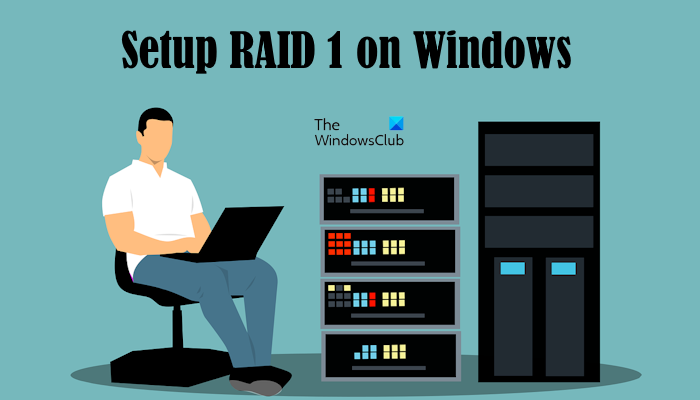
How to setup RAID 1 on Windows 11/10
RAID technology requires dynamic disks. Hence, if you want to set up RAID 1 on your Windows 11/10 device, you need to convert your disks into dynamic disks. One such advantage of converting basic disks into dynamic disks is the support for RAID technology. Dynamic disks are not supported on Windows 11/10 Home editions. Therefore, you cannot configure RAID 1 on Windows 11/10 Home editions. Windows Server editions and Windows 11/10 editions other than Windows 11/10 Home editions support dynamic disks and you can set up RAID 1 on these editions of Windows OS.
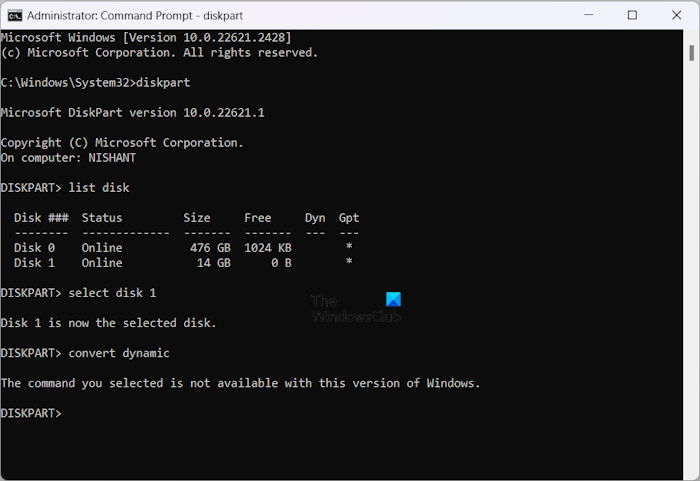
If you try to convert basic disks into dynamic disks via the Command Prompt on Windows 11/10 Home, you will get the following error message:
The command you selected is not available with this version of Windows.
RAID 1 is useful to prevent data loss. It allows you to mirror your hard disks. After configuring RAID 1 on the selected hard disks, when you copy or move data on any one hard disk, Windows automatically copies it to the second hard disk.
The Disk Management will show you the two hard disks but if you open the File Explorer, you will see only one hard disk there. Hence, if one of your hard disks fails, your data will not be lost as it is also saved on the second hard disk. You can recover it easily. To configure RAID 1, you need at least two hard disks and all the hard disks should be of the same capacity. Also, all the disks should have the same File System, preferably NTFS.
Here, we will show you the following methods to setup RAID 1 on your Windows 11/10 computer.
- Via the Settings app
- Via the Control Panel
- By using the Disk Management
Let’s start. Before you proceed, we recommend you backup all your data from the hard disks to be configured for RAID 1. This is because Windows will format your hard disks while setting them up for RAID 1.
1] Setup RAID 1 on Windows 11/10 via the Settings app
Go through the following instructions to setup RAID 1 on Windows 11/10 via Settings.
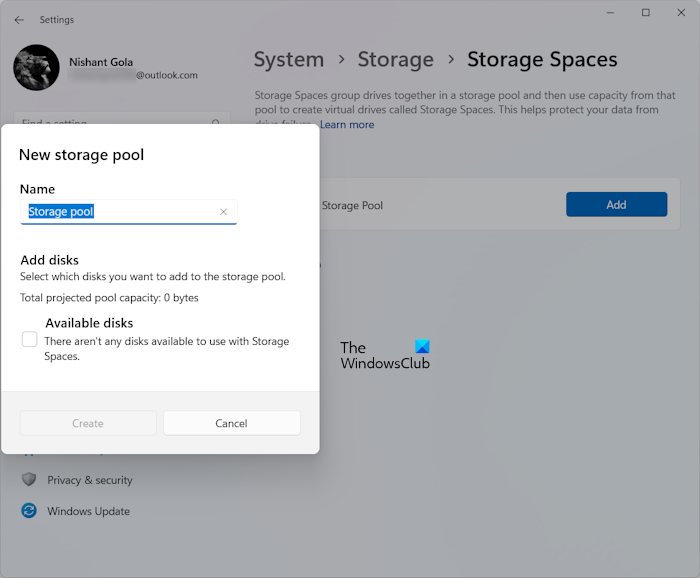
- Open Windows 11/10 Settings.
- Go to System > Storage.
- Scroll down and expand Advanced Storage Settings.
- Click on the Storage Spaces option.
- To add a new Storage Pool, click on the Add button.
- Make sure that both the hard disks are connected to your system. Type the name of your Storage Pool. Windows will automatically detect and show the connected hard disks.
- Select your hard disks and click Create.
- On the next screen, select Two-way mirror in the Resiliency drop-down. You can read the description of the Two-way mirror which states that the Two-way mirror writes two copies of your data and requires at least two physical hard disks.
- Click Create. Assign a drive letter and select NTFS in the File System.
- Now, click Format.
Read: What are RAID Levels?
2] Setup RAID 1 on Windows 11/10 through the Control Panel
Control also provides an option to configure and setup RAIDs. Let’s see the steps to setup RAID 1 on Windows 11/10 computers through the Control Panel.
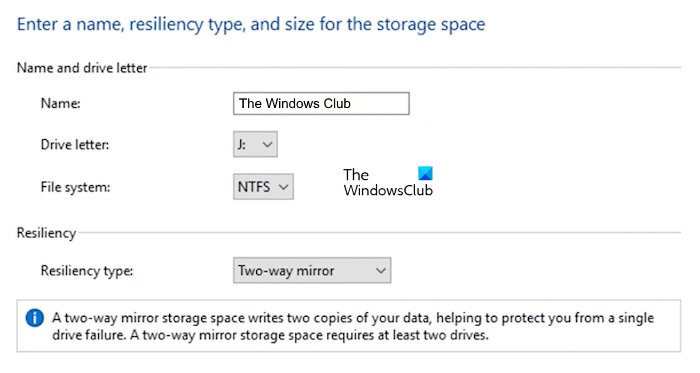
- Open the Control Panel.
- Select Category in the View by mode.
- Select System and Security > Storage Spaces.
- Now, click on the “Create a new pool and storage space” link.
- Make sure that you have connected your hard disks to your system. Windows will automatically detect the connected hard disks. Select your hard disks to be configured for RAID 1 and click Create pool.
- On the next screen, give a name to your storage space, assign a drive letter, select NTFS in the File System, and select Two-way mirror in the Resiliency type drop-down.
- Select the size of your storage pool and click Create storage space.
After following the above steps, Windows will format your hard disks and configure them for RAID 1.
3] Setup RAID 1 on Windows 11/10 by using the Disk Management
You can also setup RAID 1 on your Windows 11/10 computer via the Disk Management app. Let’s see how to do that:
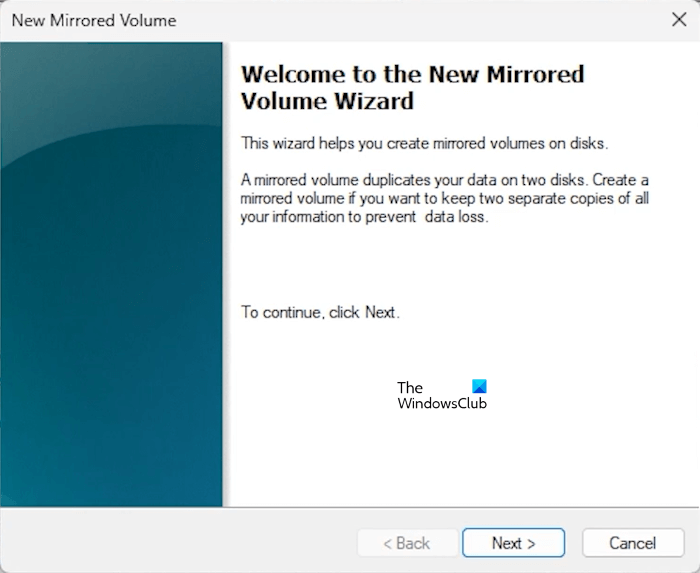
- Press the Win + X keys to open the Disk Management app.
- Make sure that you have connected your disks to your system.
- Your disks should show Unallocated space in Disk Management. If not, right-click on them and select Delete Volume. This action will erase all data saved on your disk. Hence, do not forget to backup data before performing this action.
- Now, when both the targeted disks show unallocated space, right-click on any one of them and select New Mirrored Volume.
- Click Next in the setup wizard. All the disks available for RAID 1 will be displayed on the next screen. Select the available hard disk and click Add.
- Click Next. Assign a drive letter and click Next.
- On the next screen, select the second option that says “Format this volume with the following settings.” Select NTFS in the File System and assign a Volume Label.
- Click Next. Windows will show you information about the selected hard disks and the settings you made in the wizard for RAID 1, so you can modify settings by going back. Check them and click Finish.
After performing the above steps, Windows will take some time to format both the selected hard disks. Now, RAID 1 has been set up on your computer. If you open the File Explorer, you will see only one hard disk instead of two with the same volume label and volume letter you assigned to them in the setup wizard for RAID 1.
That’s it. I hope this helps.
Does Windows 11 support RAID?
Yes, Windows 11 supports RAID. To create RAID, the basic requirement is the dynamic disks. Windows 11 Home editions do not support dynamic disks. Therefore, you can create RAID on Windows 11 editions other than Windows 11 Home.
How to enable RAID 1 in BIOS?
To enable RAID 1 in BIOS, your BIOS should support RAID. To check this, visit the official website of your computer manufacturer. If your BIOS supports RAID setup, you can enable it by following the instructions mentioned on your computer manufacturer’s official website.
Read next: Fix Mirrored Volume missing after reinstalling Windows.